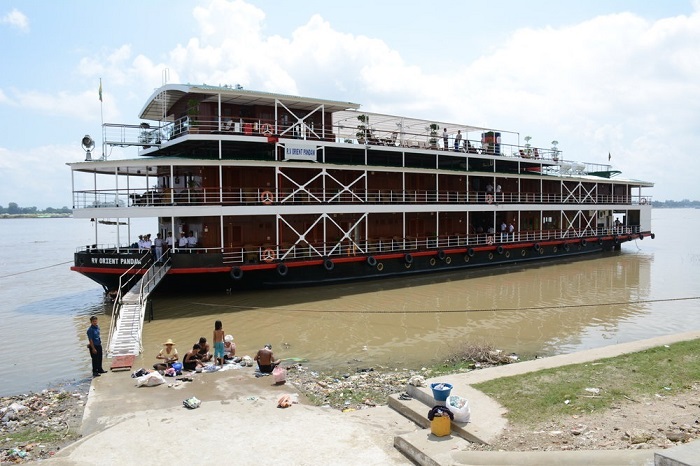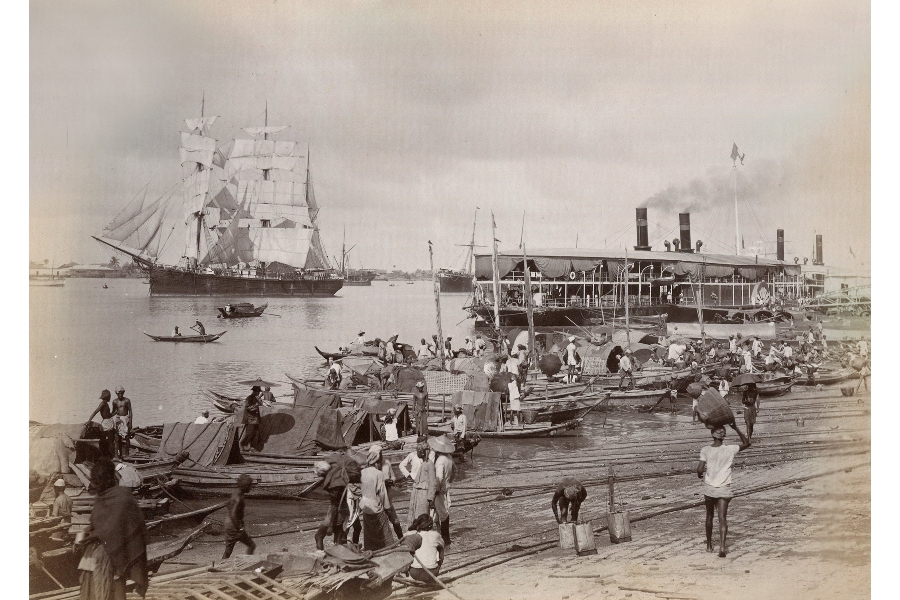[dropcap]”T[/dropcap]here is one thing we must warn you about,” said purser Maung Maung Naing, casting a wary eye across the passengers on the deck. “Please do not bring aboard any white flowers.”
He let that sit for a moment, then elaborated in a refined English accent: “It is bad luck, you see. We are superstitious about white flowers. So if you go ashore and a local lady places a garland of jasmine around your neck or you want to buy some frangipani at the market … please don’t bring them aboard the ship!”
It was a charming seafarer’s tale, I thought – all part of the mystery and exotic intrigue that a river cruise in Burma should be.
But there was an ominous glint in Maung Maung Naing’s eye that suggested he wasn’t joking.

Where the old flotilla lay
With a couple of blasts on the horn, the Orient Pandaw cast off slowly from the jetty in Sagaing. I stood by the rails and watched as women in sarongs washed clothes in the river below, and children splashed and waved at us.
Dressed in all whites, the captain and his staff were on top deck to join today’s passengers for welcome cocktails. Three storeys high, panelled in teakwood, and with an imitation smoke funnel, a Pandaw ship looks like it sailed off the page from a Rudyard Kipling poem. State rooms sleep two passengers; they are immaculate and cozy, finished in polished teak and brass fittings.
I was sailing from Mandalay to Bagan, a leisurely two-day journey. This was my third river cruise with this firm; I previously sailed the Rajang River in Borneo, and the Mekong from Saigon to the ancient ruins of Angkor.
It was 20 years, almost to the day, since this Scottish company first weighed anchor on the Irrawaddy River, and I was delighted to be a part of this anniversary trip.
Pandaw is the brainchild of Paul Strachan, a scholar of Burmese art and history, who had the precarious notion of resurrecting the Irrawaddy Flotilla Company. He had a nostalgic interest in the colonial enterprise: his great-grandfather was a captain on ships that navigated the voyage from Glasgow to Rangoon during the heady days of the British Raj. Back in the mid-19th-century, a syndicate of Glaswegian traders and shipbuilders launched the first fleet of paddle steamers known as the Irrawaddy Flotilla to serve British interests in Burma—transporting soldiers to the colonialists’ northernmost garrisons, exporting timber and rice, and escorting dignitaries to the court of the king in Mandalay.

The paddle steamers were built on the River Clyde, then dismantled and shipped to Mandalay to be reassembled. The Irrawaddy Flotilla Company became known at the time as the greatest river fleet in the world. At its peak in 1930, the company had 602 ships running from Rangoon to Upper Burma. Some were 93 metres (305 feet) long with deck capacity for 3,000 passengers.
The majestic steamers were generally built without a bridge. The captain steered from the bow underneath a veranda which offered first-class passengers the best views while they sipped their afternoon tea. (Nowadays, you’ll be relieved to know, the captain of a Pandaw ship is afforded the upper deck.)
During WWII, the fleet was scuttled to stop it falling into Japanese hands. And these paddles steamers may have disappeared forever if it hadn’t been for Strachan, who in 1997 came across the rusting hulk of a British-era paddle steamer while taking an evening stroll along the riverside in Mandalay.
“Come you back to Mandalay,
Where the old Flotilla lay:
Can’t you ‘ear their paddles chunkin’ from Rangoon to Mandalay?”
–from the poem Mandalay, by Rudyard Kipling
Strachan had at that time been skirting the “tourism sanctions” imposed on Burma by Western countries in response to calls from Aung San Suu Kyi. Two years earlier, he had been given the green light by no other than former spy chief Gen. Khin Nyunt to charter a government-owned vessel named the Irrawaddy Princess, which he marketed to a smattering of foreign guests. However, the discovery of the scuttled Clydeside steamer lying forlorn in a muddy embankment clearly captured his heart; he ploughed ahead, bought the 200-foot ship from what was then the Inland Water Transport department, and set about turning her into the first Pandaw.
Twenty years later, Pandaw River Cruises offers river trips as far north as Nagaland on the Chindwin, and as far south as the Irrawaddy delta. It also has expeditions in India, Vietnam and Cambodia.
The flotilla’s Cinderella story has not been without setbacks: Strachan has constantly had to deal with a rollercoaster of issues: bureaucracy and corruption, mutinies, fussy passengers, and drunken captains, to name but a few. “No two voyages are ever the same,” he exclaims in his book The Pandaw Story, published this year in celebration of the 20th anniversary.
Without doubt, the Pandaw team’s greatest moment came in the unlikeliest of settings: the horrific aftermath of Cyclone Nargis in 2008, when some 140,000 people were killed. Strachan loaned two of his ships to British charities Merlin and Save The Children to be converted into mobile clinics. Lives were saved; babies were born on board; and the Pandaw continues to raise donations for the devastated region to this day.
A year after Nargis, a fifth ship, the RV Orient Pandaw, was built in Saigon and sailed across the South China Sea to the port of Sibu in Sarawak, the Malaysian province on the north side of the island of Borneo.
Tours of Borneo’s Rajang River launched in June 2009 and reservations for state rooms were snapped up quickly: more than 50 percent of passengers were previous guests, predominantly British and Australians.
In September of that year, Pandaw launched perhaps its most ambitious cruise of all—a 14-day journey on the River Ganges in India, upriver from Calcutta to Varanasi.
Strachan, as always, joined the maiden voyage. The ship ran aground on a sandbar. On his website, he admitted to being “close to tears” from the delays, the bureaucracy and the disappointments inherent when expecting five-star conditions in a third world country.
Itineraries were hastily redrawn, with more nights given to hotels than to cabins. Then, as now, warnings are issued to would-be holidaymakers that rather than expecting a five-star pampering, they should be aware that the levels of uncertainty and conspiracy dictate that these voyages should only be undertaken by the adventurous and the culturally flexible.
 Tours on a Pandaw cruise are not cheap: a bed on the 10-night Irrawaddy River journey from Bagan to Mandalay to Katha costs a minimum of US$3,200 per person; as does the new Red River trip from Halong Bay to Hoa Ha via Hanoi.
Tours on a Pandaw cruise are not cheap: a bed on the 10-night Irrawaddy River journey from Bagan to Mandalay to Katha costs a minimum of US$3,200 per person; as does the new Red River trip from Halong Bay to Hoa Ha via Hanoi.
What puts these river tours in a class of their own is their uniqueness. Cruises are often thought of as floating hotels for the elderly: lavish buffets, swimming pools, table tennis competitions. What Paul Strachan has done is take an adventure and make it comfortable. On a river, there’s always somewhere to drop anchor, always a village that offers an insight into local life, whether it be a visit to the headhunting Iban tribesmen of Borneo or the smoldering crematoria of Varanasi.
Strachan has also rekindled a wee glimmer of what life was like during the days of the British Raj: where you can settle in a deck chair of a slow boat at sunset, gin and tonic in hand, and watch the mysterious world of tropical Asia pass by before your eyes.
For more information: www.pandaw.com



